Untrained Metamaterial-Based Coded Aperture Imaging Optimization Model Based on Modified U-Net
Abstract
1. Introduction
2. Theoretical Analysis
2.1. MCAI System Structure and Imaging Model
2.2. DMCAI Optimization Model
2.3. Modified U-Net Architecture
2.4. Solution of the Proposed Model
| Algorithm 1 STAIR algorithm |
| Parameters: Iterations: , Learning rate: , Adam (, ), : 100 Input: Reference Matrix , echo signal |
| 1: Initialize: Random initialization U-Net weights , |
| 2: for step do |
| 3: if = =1 then |
| 4: , |
| 5: else |
| 6: , |
| 7: end if |
| 8: , , |
| 9: // calculate the gradient of the loss function |
| 10: |
| 10: |
| 11: end for |
| Output: High-resolution imaging results |
3. Simulation Results
4. Experimental Results
5. Discussion
6. Conclusions
Author Contributions
Funding
Data Availability Statement
Acknowledgments
Conflicts of Interest
References
- Huang, Y.; Wen, C.; Chen, Z.; Chen, J.; Liu, Y.; Li, J.; Hong, W. HRWS SAR Narrowband Interference Mitigation Using Low-Rank Recovery and Image-Domain Sparse Regularization. IEEE Trans. Geosci. Remote Sens. 2022, 60, 5217914. [Google Scholar] [CrossRef]
- Kim, K.H.; Kim, H.; Kim, D.Y.; Kim, S.K.; Chun, S.H.; Park, S.J.; Jang, S.M.; Chong, M.K.; Jin, H.S. Development of planar active phased array antenna for detecting and tracking radar. In Proceedings of the 2018 IEEE Radar Conference (RadarConf18), Oklahoma City, OK, USA, 23–27 April 2018; pp. 0100–0103. [Google Scholar]
- Cui, T.; Qi, M.; Wan, X.; Zhao, J.; Cheng, Q. Coding metamaterials, digital metamaterials and programmable metamaterials. Light Sci. Appl. 2014, 3, e218. [Google Scholar] [CrossRef]
- Lan, F.; Wang, L.; Zeng, H.; Liang, S.; Song, T.; Liu, W.; Mazumder, P.; Yang, Z.; Zhang, Y.; Mittleman, D.M. Real-time programmable metasurface for terahertz multifunctional wave front engineering. Light Sci. Appl. 2023, 12, e191. [Google Scholar] [CrossRef] [PubMed]
- Tropp, J.A.; Gilbert, A.C. Signal recovery from random measurements via orthogonal matching pursuit. IEEE Trans. Inf. Theory 2007, 53, 4655–4666. [Google Scholar] [CrossRef]
- Wang, D.; Yan, Y.; Liu, Y.; Ding, J. Model recovery for Hammerstein systems using the hierarchical orthogonal matching pursuit method. J. Comput. Appl. Math. 2019, 345, 135–145. [Google Scholar] [CrossRef]
- Cheng, L.; Yin, F.; Theodoridis, S.; Chatzis, S.; Chang, T.-H. Rethinking Bayesian Learning for Data Analysis: The art of prior and inference in sparsity-aware modeling. IEEE Signal Process. Mag. 2022, 39, 18–52. [Google Scholar] [CrossRef]
- Wipf, D.P.; Rao, B.D. Sparse Bayesian Learning for Basis Selection. IEEE Trans. Signal Process. 2004, 52, 2153–2164. [Google Scholar] [CrossRef]
- Tikhonov, A. Solution of incorrectly formulated problems and the regularization method. Soviet Math 1963, 4, 1035–1038. [Google Scholar]
- Lefkimmiatis, S. Non-local color image denoising with convolutional neural networks. In Proceedings of the 2017 IEEE Conference on Computer Vision and Pattern Recognition (CVPR), Honolulu, HI, USA, 21–26 July 2017; pp. 5882–5891. [Google Scholar]
- Ledig, C.; Theis, L.; Huszar, F.; Caballero, J.; Cunningham, A.; Acosta, A.; Aitken, A.; Tejani, A.; Totz, J.; Wang, Z.; et al. Photo-realistic single image super-resolution using a generative adversarial network. In Proceedings of the 2017 IEEE Conference on Computer Vision and Pattern Recognition (CVPR), Honolulu, HI, USA, 21–26 July 2017; pp. 105–114. [Google Scholar]
- Tai, Y.; Yang, J.; Liu, X. Image super-resolution via deep recursive residual network. In Proceedings of the 2017 IEEE Conference on Computer Vision and Pattern Recognition (CVPR), Honolulu, HI, USA, 21–26 July 2017; pp. 2790–2798. [Google Scholar]
- Gan, F.; Luo, C.; Wang, H.; Deng, B. Robust Compressive Terahertz Coded Aperture Imaging Using Deep Priors. IEEE Geosci. Remote Sens. Lett. 2022, 19, 3511205. [Google Scholar] [CrossRef]
- Gao, J.; Deng, B.; Qin, Y.; Wang, H.; Li, X. Enhanced Radar Imaging Using a Complex-Valued Convolutional Neural Network. IEEE Geosci. Remote Sens. Lett. 2019, 16, 35–39. [Google Scholar] [CrossRef]
- Zhao, D.; Guo, G.; Ni, Z.K.; Pan, J.; Yan, K.; Fang, G. WAEGAN: A GANs-Based Data Augmentation Method for GPR Data. IEEE Geosci. Remote Sens. Lett. 2023, 20, 3509005. [Google Scholar] [CrossRef]
- Ishak, K.; Appenrodt, N.; Dickmann, J.; Waldschmidt, C. Human Motion Training Data Generation for Radar Based Deep Learning Applications. In Proceedings of the 2018 IEEE MTT-S International Conference on Microwaves for Intelligent Mobility (ICMIM), Munich, Germany, 15–17 April 2018; pp. 1–4. [Google Scholar]
- Ulyanov, D.; Vedaldi, A.; Lempitsky, V. Deep image prior. In Proceedings of the IEEE Conference on Computer Vision and Pattern Recognition (CVPR), Salt Lake City, UT, USA, 18–23 June 2018; pp. 9446–9454. [Google Scholar]
- Qiao, M.; Yuan, X. Coded aperture compressive temporal imaging using complementary codes and untrained neural networks for high-quality reconstruction. Opt. Lett. 2023, 48, 109–112. [Google Scholar] [CrossRef]
- Wang, W.; Wen, F.; Yan, Z.; Liu, P. Optimal transport for unsupervised denoising learning. IEEE Trans. Pattern Anal. Mach. Intell. 2023, 45, 2104–2118. [Google Scholar] [CrossRef]
- Wang, F.; Wang, C.; Chen, M.; Gong, W.; Zhang, Y.; Han, S.; Situ, G. Far-field super-resolution ghost imaging with a deep neural network constraint. Light Sci. Appl. 2022, 11, 1. [Google Scholar] [CrossRef]
- Lin, H.; Zhuang, Y.; Huang, Y.; Ding, X. Self-Supervised SAR Despeckling Powered by Implicit Deep Denoiser Prior. IEEE Geosci. Remote Sens. Lett. 2022, 19, 5504205. [Google Scholar] [CrossRef]
- Cannas, E.D.; Mandelli, S.; Bestagini, P.; Tubaro, S.; Delp, E.J. Deep Image Prior Amplitude SAR Image Anonymization. Remote Sens. 2023, 15, 3750. [Google Scholar] [CrossRef]
- Kingma, D.P.; Ba, J.L. ADAM: A method for stochastic optimization. arXiv 2015, arXiv:1412.6980. [Google Scholar]
- Chen, S.; Luo, C.; Deng, B.; Qin, Y.; Wang, H. Study on coding strategies for radar coded-aperture imaging in terahertz band. J. Electron. Imaging 2017, 26, 053022. [Google Scholar] [CrossRef]
- Needell, D.; Tropp, J.A. CoSaMP: Iterative signal recovery from incomplete and inaccurate samples. Appl. Comput. Harmon. Anal. 2009, 26, 301–321. [Google Scholar] [CrossRef]
- Wang, F.; Wang, H.; Wang, H.; Li, G.; Situ, G. Learning from simulation: An end-to-end deep-learning approach for computational ghost imaging. Opt. Express 2019, 27, 25560–25572. [Google Scholar] [CrossRef]
- Falk, T.; Mai, D.; Bensch, R.; Çiçek, Ö.; Abdulkadir, A.; Marrakchi, Y.; Böhm, A.; Deubner, J.; Jäckel, Z.; Seiwald, K.; et al. U-Net: Deep learning for cell counting, detection, and morphometry. Nat. Methods 2019, 16, 67–70. [Google Scholar] [CrossRef] [PubMed]
- Li, C.; Yin, W.; Jiang, H.; Zhang, Y. An efficient augmented Lagrangian method with applications to total variation minimization. Comput. Optim. Appl. 2013, 56, 507–530. [Google Scholar] [CrossRef]
- Wang, Z.; Bovik, A.C.; Sheikh, H.R.; Simoncelli, E.P. Image quality assessment: From error visibility to structural similarity. IEEE Trans. Image Process. 2004, 13, 600–612. [Google Scholar] [CrossRef] [PubMed]
- Gan, F.; Liang, C.; Luo, C.; Wang, H. A Method Based on Equivalent Measurement of Radiation Fields for Coded-Aperture Imaging with System Errors. IEEE Geosci. Remote Sens. Lett. 2023. accepted. [Google Scholar] [CrossRef]
- Hoyer, P.O. Nonnegative matrix factorization with sparseness constraints. J. Mach. Learn. Res. 2004, 5, 1457–1469. [Google Scholar]
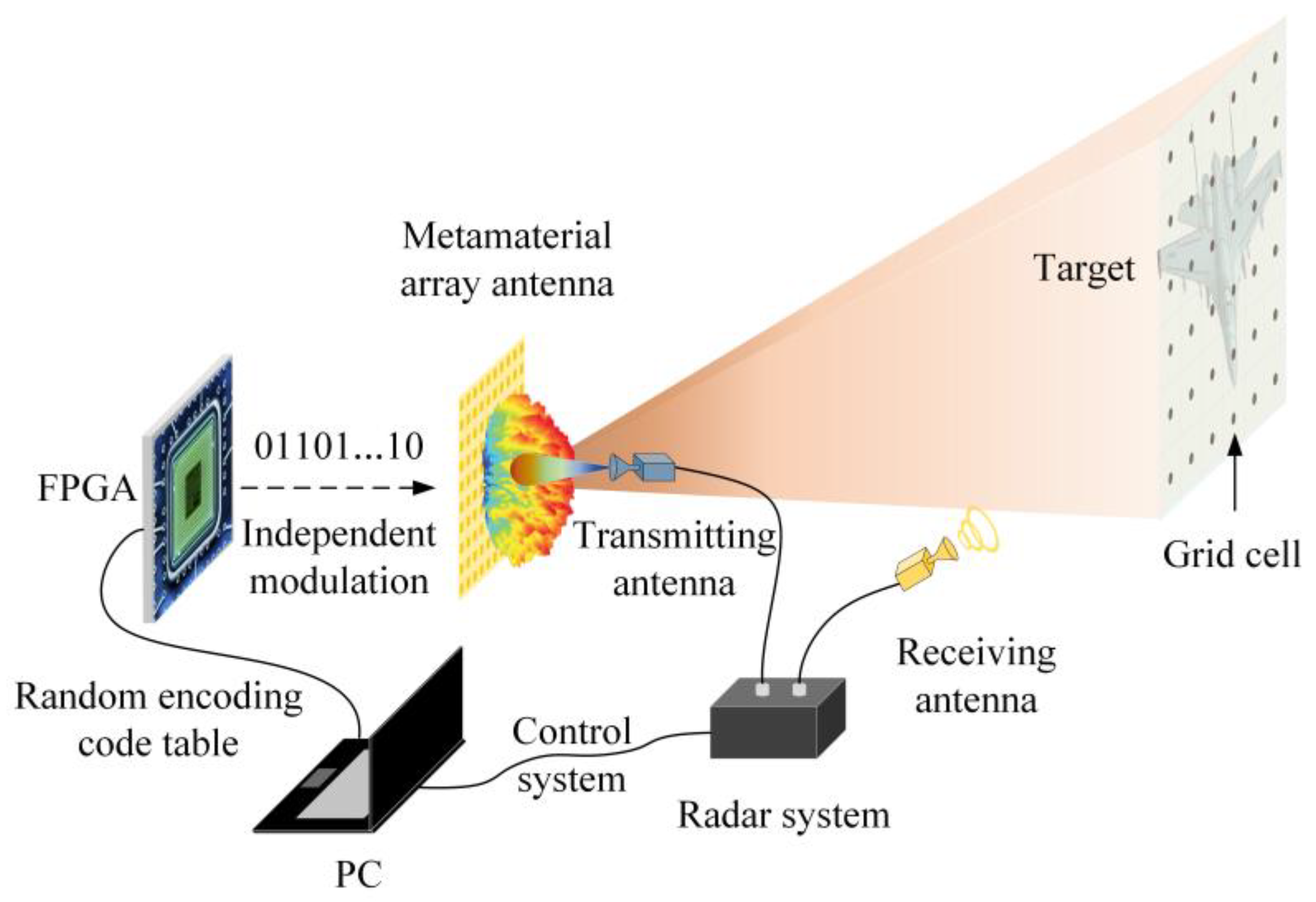


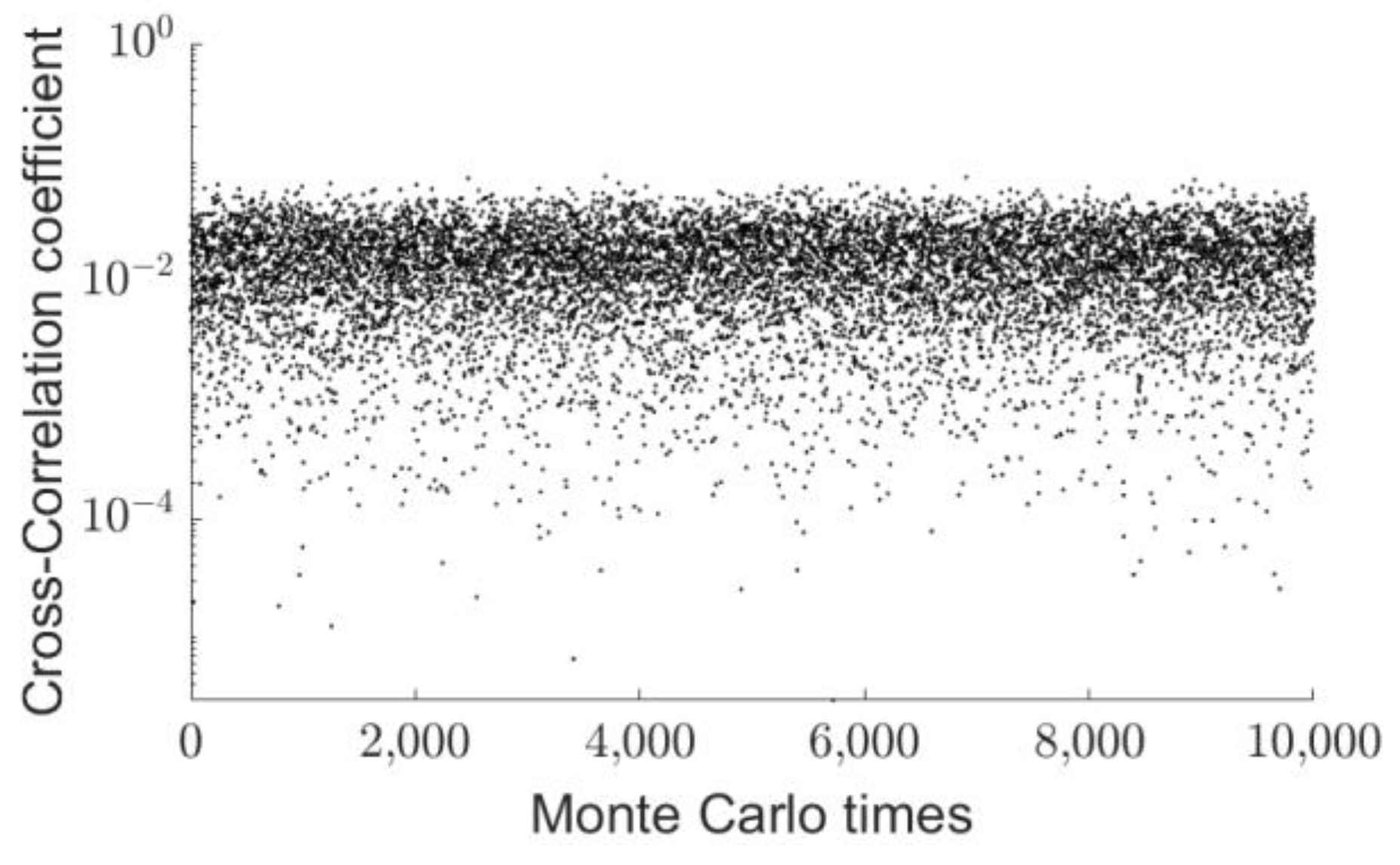


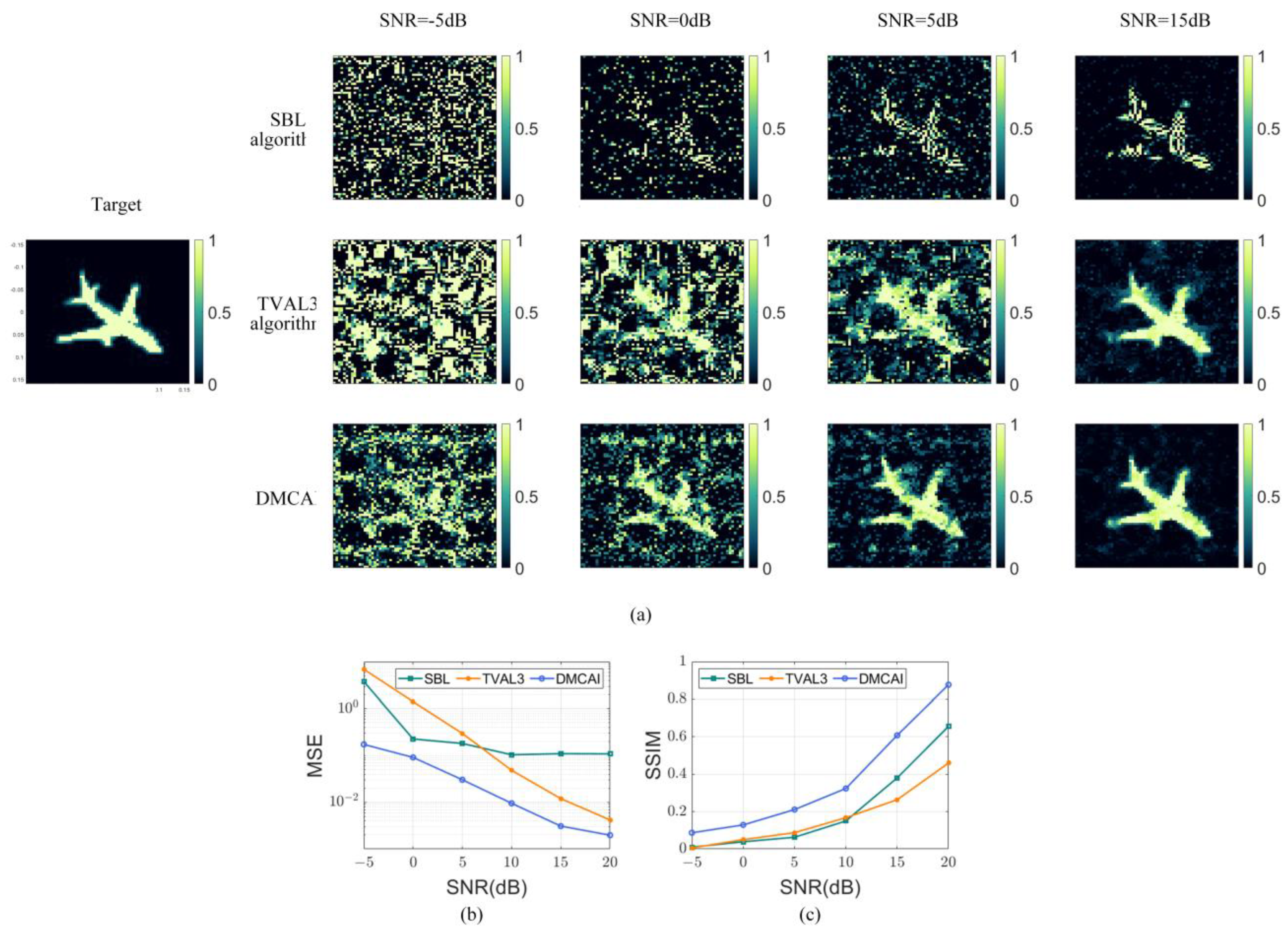


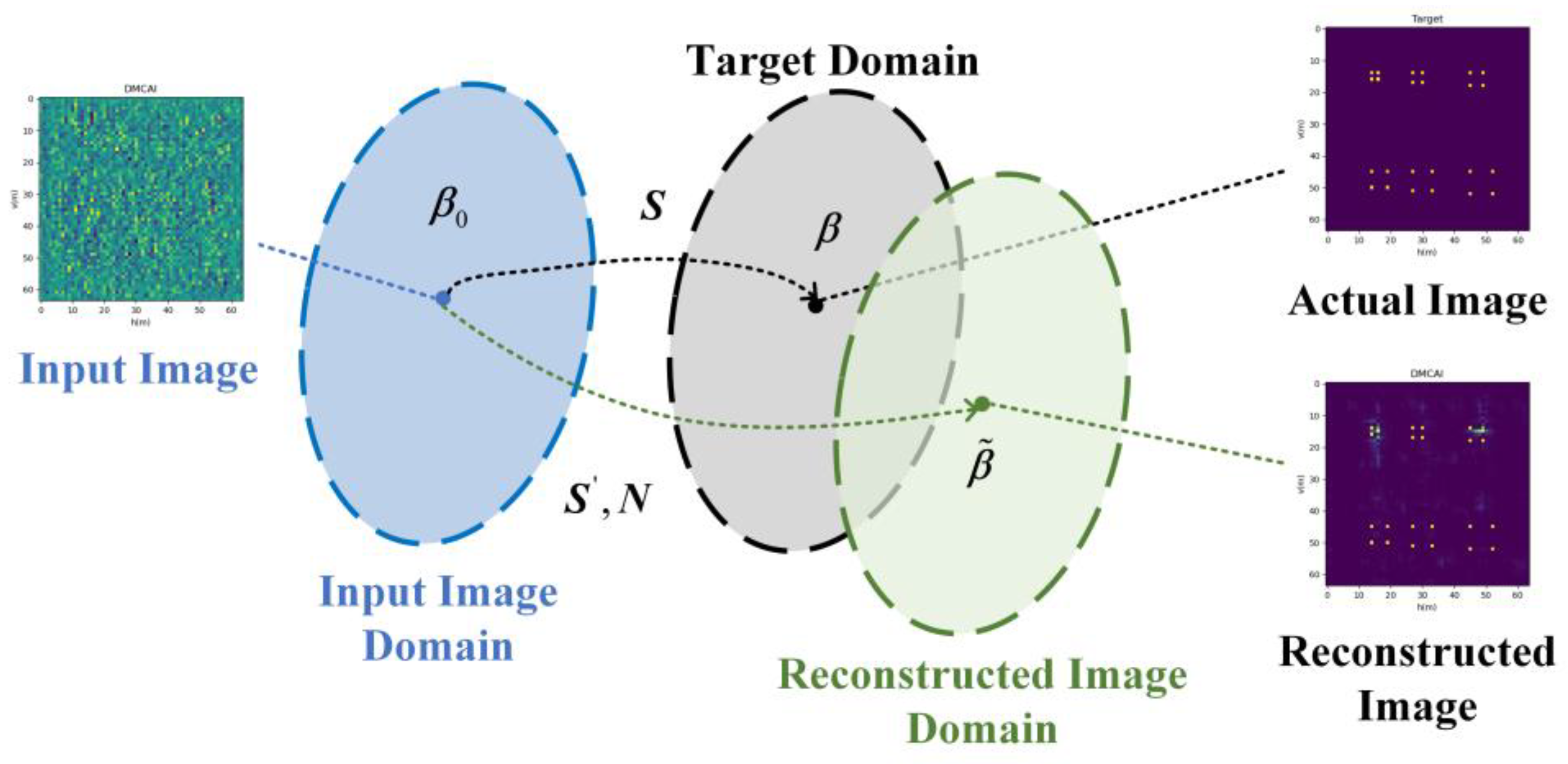
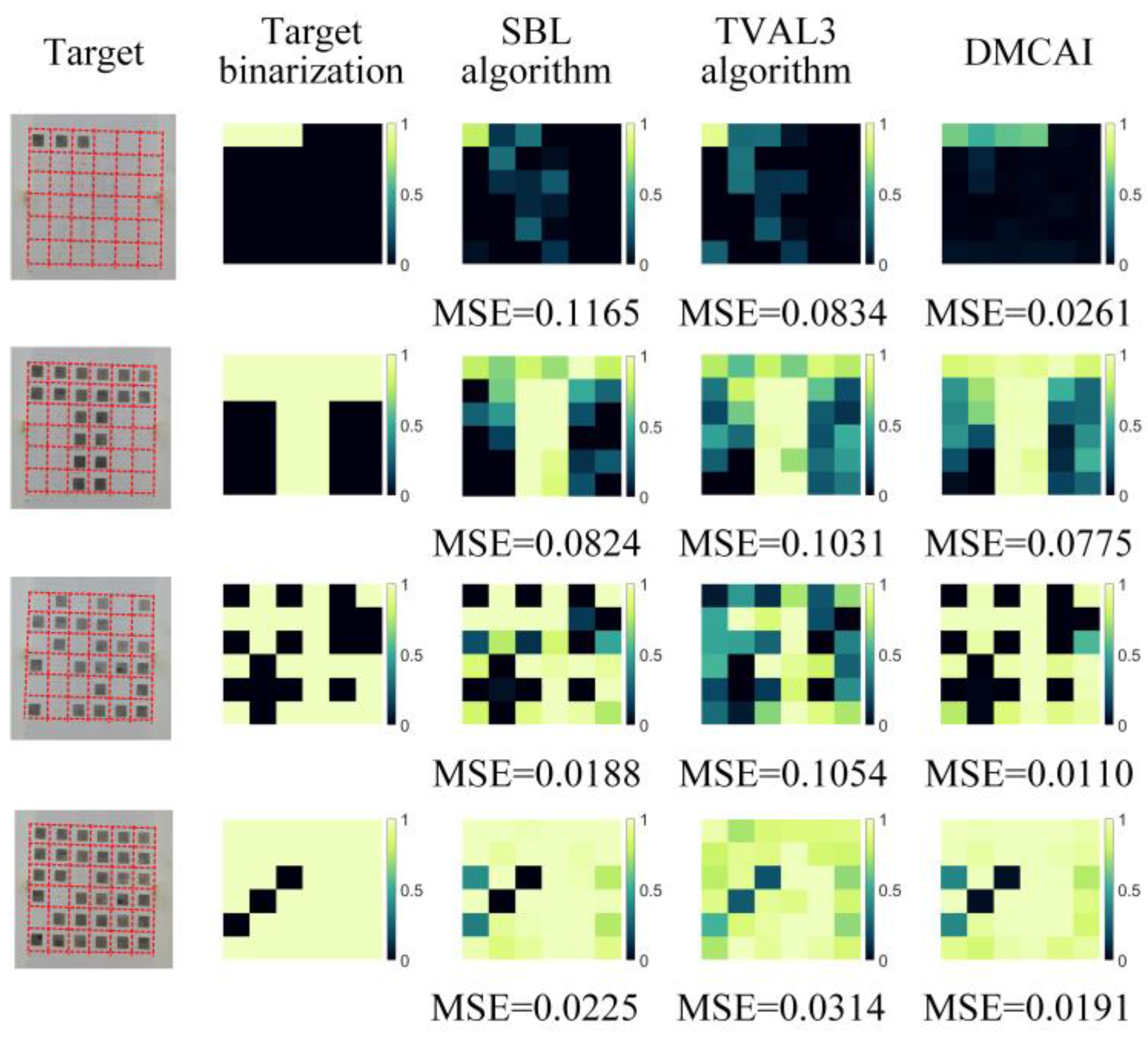

| Parameters | Value |
|---|---|
| Center frequency | 340 GHz |
| Bandwidth | 20 GHz |
| Size of metamaterial antenna array | |
| Size of imaging plane | |
| Imaging distance | |
| Number of metamaterial coding unit | |
| Number of grid cells in the imaging plane | |
| Sample numbers | 2001 |
| Data Use | & STAIR | |||
|---|---|---|---|---|
| MSE | 0.00299 | 0.00279 | 0.00207 | 0.00198 |
| SSIM | 0.695 | 0.763 | 0.881 | 0.877 |
| Time (s) | 73.167 | 71.667 | 123.817 | 70.764 |
| Parameters | Value |
|---|---|
| Center frequency | 28 GHz |
| Bandwidth | 2 GHz |
| Size of metamaterial antenna array | |
| Size of imaging plane | |
| Imaging distance | |
| Number of metamaterial coding unit | |
| Number of grid cells in the imaging plane | |
| Sample numbers | 401 |
| SNR = 20 dB | MSE | 0.0037 | 0.0034 | 0.0029 | 0.0030 | 0.0032 | 0.0033 |
| SSIM | 0.7832 | 0.7966 | 0.8361 | 0.8555 | 0.8684 | 0.8585 | |
| SNR = 5 dB | MSE | 0.0326 | 0.0326 | 0.0246 | 0.0195 | 0.0123 | 0.0084 |
| SSIM | 0.2071 | 0.2089 | 0.2364 | 0.2577 | 0.3657 | 0.6586 |
Disclaimer/Publisher’s Note: The statements, opinions and data contained in all publications are solely those of the individual author(s) and contributor(s) and not of MDPI and/or the editor(s). MDPI and/or the editor(s) disclaim responsibility for any injury to people or property resulting from any ideas, methods, instructions or products referred to in the content. |
© 2024 by the authors. Licensee MDPI, Basel, Switzerland. This article is an open access article distributed under the terms and conditions of the Creative Commons Attribution (CC BY) license (https://creativecommons.org/licenses/by/4.0/).
Share and Cite
Cheng, Y.; Luo, C.; Zhang, H.; Liang, C.; Wang, H.; Yang, Q. Untrained Metamaterial-Based Coded Aperture Imaging Optimization Model Based on Modified U-Net. Remote Sens. 2024, 16, 795. https://doi.org/10.3390/rs16050795
Cheng Y, Luo C, Zhang H, Liang C, Wang H, Yang Q. Untrained Metamaterial-Based Coded Aperture Imaging Optimization Model Based on Modified U-Net. Remote Sensing. 2024; 16(5):795. https://doi.org/10.3390/rs16050795
Chicago/Turabian StyleCheng, Yunhan, Chenggao Luo, Heng Zhang, Chuanying Liang, Hongqiang Wang, and Qi Yang. 2024. "Untrained Metamaterial-Based Coded Aperture Imaging Optimization Model Based on Modified U-Net" Remote Sensing 16, no. 5: 795. https://doi.org/10.3390/rs16050795
APA StyleCheng, Y., Luo, C., Zhang, H., Liang, C., Wang, H., & Yang, Q. (2024). Untrained Metamaterial-Based Coded Aperture Imaging Optimization Model Based on Modified U-Net. Remote Sensing, 16(5), 795. https://doi.org/10.3390/rs16050795







